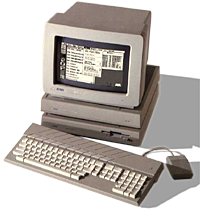A new software culture
The Atari ST computer came along soon after Antic’s software publishing operation launched, opening a whole new market for original software. Because of two specific developments, Gary was able to tackle this market in a new way:
For one, Gary discovered he could work directly with software developers in a collaborative manner, rather than simply providing a publishing service. A good example of this collaboration was the Flash telecommunications product, which quickly became (and forever remained) the de facto standard on the Atari ST for modem-based networking and CompuServe access:
Flash is one of my dream-come-true products since I’d had fantasies of a decent telecom program for a couple of years and finally found those two guys [John Chiazzese and Alan Page] in Toronto. It was the first time a programmer really listened to my ideas and implemented them and I saw how powerful that could be.
The other major epiphany for Gary was CompuServe. Prior to the commercialization of the Internet, social computer telecommunication was done either through tiny BBS (bulletin board server) or larger national (even international) services, such as CompuServe. CompuServe hosted several Atari forums managed by Ron Luks, and one of the busiest belonged to Antic. The forum did two significant things for Gary and his publishing operation: First, it put him in direct contact with an active portion of his customer base. Gary could talk directly with the people buying his products and tailor the products appropriately. Second, it provided a medium for his customers to interact with each other as a community. People from disparate parts of the world using the same software could now share information—and ultimately, their computer artwork—with minimal attention or resources from Antic. In fact, on-line computer art exchange was already well under way with both the Atari 800 crowd and the ST users who had software like Tom Hudson’s DEGAS digital paint program. Gary took all this activity to the next logical level by making “user community” an official part of software development at Antic. The on-line arm of his graphics community was the “Cyber Connection” forum on CompuServe, which provided both an official face (like a commercial Web site) and a more casual message board system for free discussions.
The combination of direct collaboration with programmers and direct interaction with the end customers were two key components of the software culture that made all the subsequent graphics software possible.
Composite Video
A video signal carried by a single coaxial cable that could be made compatible with consumer televisions and VCRs. (This feature would be used by Antic’s future Cyber VCR product.)
GEM and TOS
The operating system of the Atari ST-series of personal computers was called TOS (Tramiel Operating System), which was a superset of Digital Research’s GEM (Graphical Environment Manager) system. In short, it was responsible for the Macintosh-like features (windows, drop-down menus, the mouse pointer) in most of these Antic software products.
User Interface (UI) and Graphical User Interface (GUI)
Computer programs don't actually do anything visible to the user unless the programmer goes out of the way to include visual features. These features, which often the user can interact with through a mouse or keyboard, constitute a user interface. Graphical User Interfaces further infers a level of visual sophistication in the interface beyond computer terminal text.
